Hop Press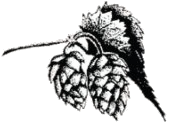
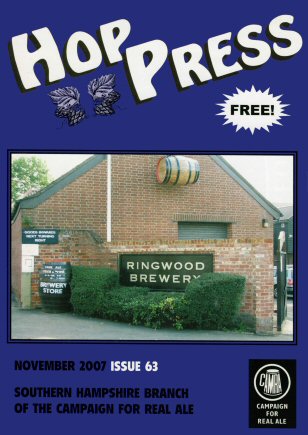
Issue 63 – November 2007
Go to Previous Hop Press Browse for another Hop Press
Go to Next Hop Press
Contents
- Editorial
- Pub News
- Fag Ends
- Competition Crossword
- 35th Good Beer Guide
- Community Pubs Foundation
- Jottings
- Walking and Drinking (5)
- The Intelligent Choice
Since our last edition, in June, the big news on the beer scene in Hampshire has been the agreed sale of Ringwood to Marston's, formerly Wolverhampton and Dudley Breweries plc.
The £19m sale was agreed after private approaches from David Welsh, Ringwood MD and owner, for a 'sympathetic' new owner wanting to carry on the best traditions of Ringwood – a company that recently came in the top hundred in a national survey to find the best firms in the UK to work for – after his impending retirement. Although David's brother Nigel continues as operations manager, David has already left for his wellearned life of leisure.
Marston's have, as far as we (CAMRA) are concerned, a somewhat patchy track record on their take-over behaviour. They bought the Mansfield brewery in 1999 and promptly closed it despite some initial emollient statements but in 2005 they acquired the Cumbrian brewer Jennings of Cockermouth and have recently invested a major sum on modernisation and enhancements. We hope that it is this latter model that will apply to Ringwood.
Given that the Ringwood purchase comes with only seven tied pubs a great proportion of the £19m must represent the 'good will' of the 750 free trade accounts. This tenuous element can only have any value as long as Ringwood beers remain and they continue to be locally brewed. From this reasoning we derive confidence in their stewardship of Hampshire's surviving regional brewery.
One tiny straw blowing in a contrary wind is their treatment of the rump of the Eldridge Pope pub estate which they also bought earlier this year. It would seem eminently sensible to gain some serendipitous marketing advantage by adding these to the seven existing Ringwood pubs, badging them as such, and so increasing the public's brand awareness. But they say categorically that they will not do this, the Eldridge Pope pubs will be fully branded as Marston's. This seems particularly a missed opportunity as some of these Eldridge Pope houses are in big urban centres such as Southampton and Winchester where Ringwood has less visibility than in the countryside.
It looked a few months ago as if the count of breweries in Hampshire was taking another drop with the quiet disappearance from trading of the White Star company. The brewery was set up in 2003 on a very cramped site in Radcliffe Road, Southampton but last year moved out to Waltham Chase on what should have been an expansion. However for reasons that are not clear the move never worked out and, in the middle of this year, the brewery just seemed to expire quietly.
But in another city nearby, a new star may be rising. To the east, Malcolm Irving, a former employee at the Gales brewery site in Horndean, has just started brewing at Irving's Brewery on the Railway Triangle Industrial Estate at Farlington in the northern outskirts of Portsmouth. First test brews have been done and by the time this is being read beers should be appearing in local pubs around Pompey.
Malcolm has said that he would like to make beers that are 'in the style of Gales' and they will probably be named in a Royal Navy theme. Other than this, as yet, we do not have any further intelligence from these distant parts.
For many editions we have reported, seemingly endlessly, on the convoluted story of the Bugle at Twyford. Bought from the derelict Eldridge Pope empire by Inntown, specialists in 'developing' pub properties, it was promptly closed and Inntown pursued plans for redeveloping the site as housing. Eventually, after a major campaign to save the pub, a compromise was agreed by the planners – a limited number of houses were permitted but with a condition that the pub must be reopened as well.
The houses are now up and for sale and the pub still has not reopened but there are small signs… Work is going on inside and at long last a licence application has been made to the Winchester council (to be decided by the end of October). The mystery now moves to the licence applicant, this is not Inntown but is given as Espar Ltd. An internet search only lists a company of this name as marine engineers at Marlow Marina on the Thames!
Once again, this October, the press is filled with doom and gloom tales of drinking excess sending the nation rapidly to hell in a handcart. This time it is the middle class, home counties commuter bringing on certain self-destruction with the odd glass of house red or pint of guest ale to relieve the stresses of the struggle home from Waterloo. What an over-hyped picture this is!
Hogarth lived at a time when such public health messages might have had some validity; Gin Lane certainly had a basis in real life and reflected real social ills (just as Beer Alley offered the solution, but that's another story). But even his genius would be hard pressed today to portray any drama from this piece of special pleading. A century ago (and a century after Gin Lane's ills were already fixed) the nation was consuming about 30 gallons of beer and over a gallon of proof spirit per head per year. Figures now do not even get to a third of these quantities.
There is a drink problem in the UK but it is a problem of attitudes not volumes. The nation seems to have a strange collective internal anger, not found in other populations (except maybe the USA, possibly a shared heritage?), that is released by alcohol as nihilist, destructive urges.
Finally, a note of appreciation from us all. In October we wished 'goodbye and happy retirement' to Val Dove the long serving licensee of Winchester's Hyde Tavern. Val had been dispensing Good Beer Guide rated real ales in the Hyde's civilized atmosphere for nineteen years, from ownership by the original Marstons, through Greene King to Admiral Taverns now.
Val left on the 22nd of October and the pub is now being leased to Andrew Burdon who has run the White Lion at Soberton for a number of years. Andrew had been a customer at the Hyde for years and jumped at the opportunity to take it on as well as the Soberton pub.
It is encouraging to know that the incoming landlord has known and appreciated the pub for years before. Once a commonplace, it is now unfortunately all too rare a thing as pubs become increasingly just soulless 'vending units.' Day-to-day management will be in the hands of Miss Izzy Pink, who has also worked for a number of years with Andrew at the White Lion.
Rob Whatley
Southampton
With autumn upon us, the students have
returned to the city to find that the Terminal in Portswood has been rebadged as one of the
Varsity chain by owners the Barracuda Group.
Before they left on summer vacation many
may have taken advantage of Portswood's
new beach, which appeared at the Mitre.
Licensee Gregg Hollister brought in 20
tonnes of sand to give the venue's beach
parties a more authentic feel.
There has been mixed news in the city on the pub closure front. The Saints pub in Millbrook has survived a second threat to its future after planners again rejected plans to build flats on the site. This was despite the revised plans including a smaller replacement pub on the site. The future of the Blacksmiths in Romsey Road is in doubt as the pub is currently boarded up. The Merry Oak is also still boarded up. A plan to build eight flats, submitted in May, was rejected and a revised application for seven flats and one retail outlet was submitted in August. The future of another long boarded up pub on the east of the city has been resolved. The Sun Inn, Weston Lane is to be replaced by a three storey doctors' surgery, a pharmacy and a dental practice. It is becoming almost a fashion for pubs to be converted into a surgeries. The Lymington Tavern in Lymington (2002), the Speckled Trout in New Milton (1998) and the Traveller's Rest in Totton (1987) have all suffered the same fate recently.
While pubs are being lost in Southampton, other establishments may be opening. A list of companies looking to open outlets in the city, which was published in the Daily Echo, included Harvester Restaurants, 'Elbow Room' pool lounge and bars and Regent Inns, who own the Bar Risa, and Walkabout chains. A new name did appear in the city centre during the summer when the Hog's Head (sic) in Above Bar became an addition to the Slug and Lettuce chain. Reopening after a long period of closure is 90 Degrees bar in Carlton Place. It previously traded as Harvey's and Mia Casa but is now run by the owners of La Margherita restaurant in Town Quay.
Freemantle now hosts a consulate, the Wellington Arms in Park Road. The tiny Caribbean island of Redonda is a dependency of Antigua. Canadian Bob Williamson claims to be the rightful king of the one mile square island. When Wellington Arms local Edward Elder visited the island in a few years ago he was "appointed" the Cardinal of Redonda. Now the cardinal has "knighted" Bob Beech, licensee of the Wellington Arms, and declared the pub to be the official British consulate of the uninhabited island. The wheeze was seen as a plan to beat the smoking laws but the authorities did not go along with the joke.
Eastleigh
Greene King have obtained permission for a
single storey extension at the rear of the
Fountain Inn, Hedge End and there have
been more extensive changes to the
Windhover Manor in Bursledon, which has
transformed itself from a Brewers' Fayre into
a Beefeater. Research into the history of the
site has discovered that it was once the home
of English flight pioneer Sir Edwin Alliott
Verdon-Roe.
In the centre of town Earth Bar closed in mid-September after it lost its licence following a catalogue of violent incidents, which got it into the top twenty of the worst trouble spots in the county. This one time Eldridge Pope pub may be demolished, a plan has been submitted for an eight storey building containing six floors of flats, a floor of offices and a ground floor of restaurant and shopping by the site owners, Inntown Properties. Around the corner in the Leigh Road pedestrian area work is going on in Stars Bar (the former Lucky Jim's) which is rumoured to be reopening soon, possibly under the Yates label. Help Wanted signs have just appeared in the bar's windows.
Otterbourne/Twyford
As mentioned in the Editorial the saga of
Inntown Properties and the Bugle Inn at
Twyford continues although the licence application
may finally mean that an end is at last in sight.
Compared with this long drawn out tale, the shock impending demise of the Captain Barnard in Otterbourne/Compton might be concluded more speedily. It was purchased from Whitbread only last year by pub group M&B (who at the same time bought the Old Forge also in Otterbourne and a little further off, the Fishers Pond). Pub staff are saying that the closure will come at the end of October when the pub's onward sale to a property developer is finalised. Any planning application for a substantial housing development is sure to be met with much opposition from local residents.
Winchester
Moving north to Winchester, plans to demolish
the Stanmore Hotel and replace it with a
65 bed nursing home were withdrawn by
applicants Colten Developments Ltd.
However, they did say at the time that they
were hoping to submit a revised application
later in the year. In Weeke a third attempt to
build an Aldi supermarket on the site of the
long demolished Chimneys pub has again
been rejected by city planners but the company
is to appeal against the decision.
One change that is going ahead is the conversion of the Guildhall Tavern in the city centre to a Pitcher and Piano. It is expected to reopen in its new guise in early November following a six figure refurbishment. The chain, which is run by Marston's, already has another outlet in Ocean Village, Southampton. There had been speculation over the future of the Guildhall for many months, with an application made, and subsequently withdrawn, to transform it into a 'Wagamama noodle bar.'
The former King's Arms in Chesil Street has now reopened as the Black Rat restaurant. It is owned by David Nicholson, who also owns the nearby Black Boy. Continuing the restaurant theme, brewers Greene King have bought the Loch Fyne fish restaurant chain, which has an outlet in Jewry Street. The chain is expected to grow from the current 36 outlets but Greene King have suggested that some of the existing restaurants may be converted into Greene King pubs. The Mash Tun in Eastgate Street has new hosts after broadcaster Peter White and his family pulled out of running the pub, which they took over in July 2004. The new owners of the Roebuck in Stockbridge Road are James Skipworth and Stefan Berry. They both previously worked at the Bugle in Hamble and are hoping to create a country style pub in the city with traditional English cuisine, made from locally sourced produce.
To the east of the city, Good Beer Guide entry the Bush at Ovington has been voted Hampshire's best county pub by readers of Hampshire Life magazine. The 16th century riverside inn, with a reputation for excellent food, is run by Nick and Cath Young.
New Forest
Another Good Beer Guide entry, this time in
the Forest, is celebrating after a competition
win. The Compass Inn at Winsor came out on top in the Daily Echo's 2007 'Pubs in Bloom' competition. The nearby Mortimer Arms at Ower has been purchased by Enterprise Inns. £50,000 is to be spent on a refurbishment while the company looks for a lessee for the substantial premises which contains 14 en suite bedrooms, a function room and a skittle alley. The same company is spending £100,000 on the refurbishment of another recent purchase, the Compasses Inn in Damerham, near Fordingbridge. Continuing with Enterprise Inns pubs, the Crown in Everton, reopened in late May after being closed for a number of months. It is being run by Phil and Janine Cooper, who ran the Rouille restaurant for the previous four years.
In Hordle, Whitbread has been successful in an application to build a 20 bedroom, two storey, Premier Travel Inn next to the Three Bells Brewers' Fayre outlet. If this and a number of other smaller hotels are successful we are likely to see more of them springing up around the country. The long running battle to get new houses built on land that was formerly part of the car park of the Carpenter's Arms in Bransgore, appears to be over, or is it? Permission has been granted to build two houses and two flats on the site. However, local residents have written to the local government ombudsman about the council's conduct during the planning process. The parish council is also to write to the district council complaining of bias. The pub, which is now owned by Fullers, continues to trade.
The Pilgrim in Marchwood is the latest local free house to be purchased by the London brewers, Fullers. Previous owner Ron Longman was one of the longest serving publicans in the Forest. He's an award winning TV cameraman who covered such events as the Torrey Canyon disaster and the build up to the Falklands War for the BBC. He and his wife Margaret, who died in 1992, took over a derelict cottage in 1976 and converted it into the Pilgrim. Later they added the Pilgrim's Progress restaurant. An application for a host of new signage has been submitted for the listed building by Fullers.
Test Valley
The previous licensee of another free house that was purchased by Fullers, the Oak Inn at Bank, is now running the Rockingham in West Wellow. Emphasis is very much on the food trade in the refurbished pub but a selection of real ales is always on offer. One foodstuff though that is in short supply this year is the pumpkin. The poor summer weather was not conducive to the growth of pumpkins, which meant that for the first time since it was founded in 1968 the annual pumpkin show at the Bear and Ragged Staff in Michelmersh had to be cancelled.
Moving south, the Knights' Cross in North Baddesley reopened in the summer following a refurbishment and in the centre of Romsey, the White Horse is due to reopen before the end of the year. Peter Bartlett has been appointed as the general manager for the 16th century coaching inn, which is currently undergoing substantial refurbishment. Another White Horse that is in line for some changes is on the Winchester Road at Ampfield, the lease of ths former Whitbread house is being offered by agents Christies. Returning to the town centre, at the Bishop Blaize a long held tradition of all pubs has been made more formal. The 'Grumpy Club' started three years ago and is held on Tuesday evenings. The 30 strong club has its own soap box on which members stand to espouse their views on the evening's chosen topic. The club's motto is, "and another thing…"
Fag Ends Hop Press index
Rob Whatley
There was a false start to the introduction of the smoking ban in pubs on 1 July in a number of towns and cities, including Fareham. The legislation enabling local authorities to issue fines for breaches of the law had to be passed by the full local council. In Fareham it had only been passed by the executive committee so until the loophole was closed at a council meeting on 26 July no action could be taken if customers in the town's pubs were caught smoking. Most councils, including Fareham, had in any case decided in advance to take an education and awareness raising approach towards any breaches in the first few weeks following the changes. In Southampton, 1,600 spot checks made by council officials since the introduction of the ban did not result in a single incidence of a breach of the law. The council is to provide 50 additional bins in targeted areas to help reduce the profusion of cigarette buts that can be seen outside busy areas, such as the railway station.
A variety of unusually designed and disguised smoking areas have sprung up both in pub gardens and in some cases outside the front of pubs. Though getting permission for outdoor smoking areas has proved a problem for some. In Ringwood an application to construct a shelter for smokers at the back of the Grade II listed Fin McCoul's has been rejected by planners as it would cause 'significant harm' to the look of the premises.
In addition to a roof, some shelters have additional facilities for smokers. The garden of the Mitre in Portswood now hosts a fruit machine, while at the Hinkler in Thornhill the dart board was moved outside as the pub's darts team were all smokers and blamed the ban for the loss of their first match in July. The River Inn at Bishopstoke has removed the need for nicotine addicts to use the pub at all by erecting an outside smokers' bar.
With the profusion of smokers clustered outside some pubs, complaints have been made by non-smokers about having to run the gauntlet through a corridor of smoke before entering a pub. Another consequence of the ban has been felt by those living close to pubs. Plans put forward by the Blonde Beer Café in Winchester for extended opening hours have been opposed by local residents who have complained about the noise and anti-social behaviour that they claim is caused by the pub's outside customers. Licensee Sat Ghuman claims that most of the complaints about noise have come about following the introduction of the smoking ban as the areas outside of the pub are now populated by smokers. Similar complains about increased noise outside of licensed premises have been raised at meetings of New Milton town and Hordle parish councils.
Another concern has been raised about the safety of female smokers going outside to smoke. There is an increased danger that drinks could be spiked if they are left unattended inside while the drinker is outside for a while smoking.
However, the move to eliminate smoking from public interiors stills seems to be popular. Amongst readers of the Daily Echo two polls since the ban have shown 74% and then 78% of readers saying that the ban has made visiting a pub a more enjoyable experience.
Competition Crossword Hop Press index
QUETZALCOATL (printable pdf version here 320KB download)
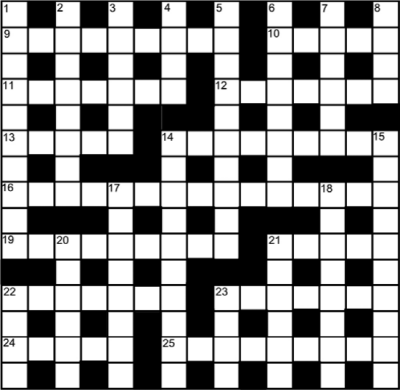
Across |
Down |
Prizes to the first two correct entries drawn. Closing date: 31st December 2007.
Send to:
The Editor Hop Press 1 Surbiton Road Eastleigh, Hants. SO50 4HY
May's Solution & Winners
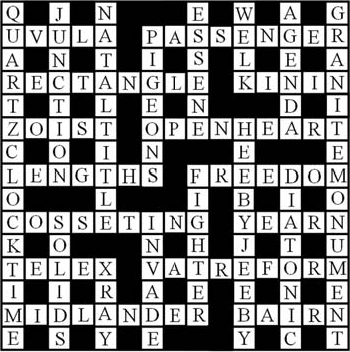
The alphabetic jigsaw used last time met with
general approval and I would like to thank
solvers who added nice comments!
As usual with an alphabet puzzle if completed, it is very unlikely to have any errors, the twelve solutions received were all correct.
A thirteenth correct solution was sent in but sadly it was from a puzzle set in the first edition of 2006!
Winners:
Kate Chessman, Southampton (Second edition running);
Roy Garraway, Reading
Other correct solutions were from:
Jocelyn Britcher; Nigel Cook;
Robin Cork; Ken Crawford;
Trevor Crowther; Philip Doughty;
John Green; Bob Howes;
Andrew Laythorpe; Harvey Saunders.
35th Good Beer Guide Hop Press index
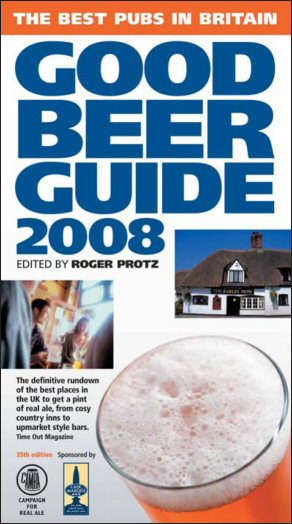 The 35th edition of CAMRA's
Good Beer Guide was published
last month. The Good Beer Guideis the only pub guide which is annually
surveyed by CAMRA's beer loving membership,
so the reader can be assured of the most
up to date information on out-standing pubs
in which to find a pint of real ale. The guide
lists the best 4,500 pubs for real ale in Britain
and also, uniquely, includes information on
every brewery in the UK.
The 35th edition of CAMRA's
Good Beer Guide was published
last month. The Good Beer Guideis the only pub guide which is annually
surveyed by CAMRA's beer loving membership,
so the reader can be assured of the most
up to date information on out-standing pubs
in which to find a pint of real ale. The guide
lists the best 4,500 pubs for real ale in Britain
and also, uniquely, includes information on
every brewery in the UK.
Of the tens of thousands of pubs that have featured in the guide over those 35 years, just ten have appeared in all 35 since 1974. Guide editor Roger Protz said: "Any pubs that appear in the Good Beer Guide have to have been nominated by their local CAMRA branch after serving consistently high quality real ale. For any pub to have appeared in every edition for 35 years is remarkable, it is only fitting that we applaud their dedication to the best in British beer."
CAMRA will award each of these 'super' pubs a commemorative plaque to mark this outstanding achievement. All of the ten pubs are hoping to host special 1970's themed parties to celebrate their amazing achievement! The 10 pubs [sadly, to date, I've only visited five — Ed.] are:
BEDFORDSHIRE
Sow & Pigs, Toddington LU5 6AA "This 19th-century inn is heated by open fires, the
long narrow bar is decorated with pigs, golf memorabilia
and paintings of the pub by local artists."
CAMBRIDGESHIRE
Queens Head, Newton CB2 5PG "Popular village establishment serving the local
community. Run by the same family for many
years, there is a framed list of the licensees since
1729 on display."
CORNWALL
Blue Anchor, Helston TR13 8EU "Rambling, unspoilt 15th-century granite
building with a thatched roof and its own
brewery at the rear. There are no distracting
games machines in the two small bars."
DEVON
New Inn, Kilmington EX13 7SF "Cosy, thatched Devon longhouse that was
rebuilt after a major fire in 2004, but retains
a warm atmosphere. Secluded gardens and the
landlord's aviaries are attractive outdoor fea-tures, while a well used skittle alley is home to
nine local teams."
DORSET
Square & Compass, Worth Matravers BH19 3LF
"Run by generations of the Newman family for
more than 100 years, this 200-year-old free
house is a cosy haven in winter with roaring
fires and flagstone floors. This local institution
has its own museum and breath-taking views of
the Jurassic coastline."
LIVERPOOL
Roscoe Head, Liverpool L1 2SX "This traditional pub has been run by the same
family for more than 20 years.
Recently refurbished, it has retained the original
layout with a tiny snug, bar, front parlour
and back room."
LONDON
Star Tavern, Belgravia SW1X 8HT "A Grade II listed building built in 1848, the
Star is well known for its award winning ales
and excellent food. The pub was reputedly used
by members of the Great Train Robbery, and it
is also associated with the notorious Lord
Lucan."
Buckingham Arms, Westminster SW1H 9EU "Located opposite the Wellington barracks and formerly a hat shop, this Grade II listed building became a pub in 1840. It has a curved mirrored bar and a drinking corridor used by the local working class during Victorian Times."
NORTHUMBERLAND
Star Inn, Netherton NE65, 7HD "Entering this unspoilt gem, privately owned
and unchanged for 80 years, feels like
entering the living room of someone's home. The
beer is served on gravity straight from the
entrance hall."
GWENT, WALES
Cherry Tree, Tintern NP16 5TH "Nestling on the steep wooded sides of the
Anghidy Valley amid scenic splendour, the
Cherry offers four real ales from smaller
independents plus cask and bottled ciders. The
pub's ground floor is the village shop and post
office."
No Scottish pubs are listed because, unfortunately, the 1974 guide only covered England and Wales, a situation that was quickly rectified the following year.
The Good Beer Guide 2008 features 53 new breweries and 1203 pubs nationwide that appear for the first time. The Guide is available in all good bookshops or can be obtained directly from CAMRA, visit our web site: www.camra.org.uk
Community Pubs Foundation Hop Press index
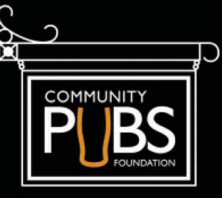 Alarmed at the increasing loss of
viable, valued pubs as we progress
into the third millennium,
CAMRA launched an important initiative
aimed at trying to stem the haemorrhage of
the nation's pub stock from closures and
subsequent 'development.' The Community
Pubs Foundation is intended to be a campaigning
aid to local groups – whether
CAMRA centred or otherwise – who are
fighting to save their treasured local from
destruction.
Alarmed at the increasing loss of
viable, valued pubs as we progress
into the third millennium,
CAMRA launched an important initiative
aimed at trying to stem the haemorrhage of
the nation's pub stock from closures and
subsequent 'development.' The Community
Pubs Foundation is intended to be a campaigning
aid to local groups – whether
CAMRA centred or otherwise – who are
fighting to save their treasured local from
destruction.
Anglophile travel writer, Bill Bryson, who perhaps recognises the wonderful unique institution that the British pub represents more acutely than the indigenous population, said of the new venture: "This is a seriously important and welcome endeavour. Any initiative that helps a community keep its local pub open has my immediate support."
The objectives of this practical 'public service' are:
- To prevent the loss of, or inappropriate alterations to, a public house of community, architectural or historical importance
- To improve the viability of a public house through the provision of community facilities
- To protect the future of a public house through community ownership.
It is primarily a resource centre and an information exchange where a body of best and most effective practice for opposing the predations of avaricious developers can be built up. Information packs are available and, in some instances, small grants may be provided to help groups set up fighting organisations.
We are losing virtually one pub every single day of the year and almost all of these will have been providing a service to their communities for at least a century, frequently several. No amount of conversions of banks and High Street furniture stores, however welcome they may be, can make up this cumulative loss of history and heritage.
In many cases it is a combination of a weak planning system (as an example, the need for a 'change of use' application can be simply avoided by demolishing a pub without warning, not in itself breaking any planning regulation!) and even weaker officials/councillors. Arming oneself with a knowledge of the tricks that the men in sharp suits favour can help to rebalance the match.
Find the Community Pubs Foundation on its website at: www.communitypubs.org.uk
There are many links to useful information sources and to current news of individual battles. Alternatively, to get more information, action packs etc. call 01727 867201 or email: communitypubs@camra.org.uk
The price of beer continues to rise, with the £3+ pint being reported in a number of local pubs in during the past year. Complaining about the price of a pint is not just a recent phenomenon, as has been proved during work to renovate Tudor House in Southampton. A beam has been exposed showing that during previous renovation work carpenters left a reminder of their displeasure at recent rises in the cost of beer. The message carved into the beam states, "1936 FED UP BEER 7d PINT," signed by J White and L Sykes. The Daily Echo traced the daughters of one worker, Laurence Sykes, who would have been 33 when he made the carving. Marion Bolger and Shelagh Ryan remember their father telling them about what he had done and often wondered if it would ever be found.
Darts legend Phil Taylor is supporting a campaign to get more dartboards into pubs. A survey earlier this year showed that only 7% of men had played darts in their local during the previous twelve months. This figure has fallen by 40% over the last five years. With the increase in the number of food oriented pubs, the once ubiquitous dartboard is becoming a much less common feature of our pubs. Let us hope the decline can be arrested and that they do not go the same way as the bar billiard table, which has all but disappeared from pubs in Hampshire. More information can be found at: www.saveourdarts.com
Time Gentleman, Please was published earlier this year and chronicles the history of pubs in Winchester. It was written by local historian Phil Yates and is published by the City of Winchester Trust, which is celebrating its 50th anniversary this year. It is available from bookshops, selected pubs in the city and the Heritage Centre.
Walking and Drinking (5) Hop Press index
Ray Massey (download .rtf file for printing)
This Autumn I would like to suggest a walk for drinkers based on Bishop's Waltham. Two very regular entries in the Good Beer Guide (since at least the early '80s) are the Bunch of Grapes in Bishop's Waltham and the Hampshire Bowman in remote Dundridge. The Bunch of Grapes is not the easiest pub to find (although the note in the GBG: "follow signs to the Church" cannot be faulted — once you find a sign!). But having found the Bunch and wetted your whistle why not continue across the downs to find the Bowman. These notes should help you. Throughout the walk it is fascinating to see the landscape changing from small country town to remote countryside.
A very short town stroll to the Bunch of Grapes
Get off the bus is St. George's Square, in the
centre of Bishop's Waltham, and walk
between two imposing banks up the very
pleasant High Street. At the end, turn right,
then immediately left into the charming St.
Peter's Street and The Bunch of Grapes
appears on the right.
Unusually, there is a price list outside, so the somewhat expensive beer prices within should come as no shock. But it's worth it. The pub is a gem: the service is courteous, the clientele very friendly and talkative, and the pub has the atmosphere of a club. Note that the tiny pub serves no food, and the opening hours are just 11 to 2 and then 6 to 11, with even shorter hours on Sunday. There is a very pleasant private garden; indeed sitting there, you could easily imagine you are the owner of a very nice town house.
Outwards to the Hampshire Bowman
When it's time to leave, turn right up St.
Peter's Street and turn half-right into the
churchyard. Continue uphill with the church
on your left, and exit by The Old Rectory.
Turn half right, down 50 yards to a triangular
junction with a more major road (Free
Street). Turn left here, slightly uphill, with
the road bending right, past a route 69 bus
stop and then immediately turn right into
Colville Drive (a reasonably up-market housing
estate). Stay on Colville Drive and at the
very end turn half right on a pavement
between substantial hedges (later fences); a
kissing gate lets you suddenly onto open land.
The path lies visible ahead, take it to cross two fields diagonally towards a hedge of small trees. Bend right along the hedge and soon turn left through it onto a sloping semi-open chalk down (Dundridge Meadow — a local Hampshire Wildlife Reserve). Just ahead is a convenient seat from which to appreciate the peaceful surroundings. The small road in the valley bottom will soon take us to the pub.
From the seat bear right and go slightly downhill to woods ahead. At the left edge of the woods go through a gate into a narrow rectangular field. Walk most of its length, keeping the woods on your right. Then, about 70 yards before the field end, cross a style in the lower hedge, and go down a track and over a style to turn right onto a small quiet road. The pub is the best part of a mile ahead. This road walk is the least satisfactory part of the route, but it is direct, there is no real alternative, and the road is so narrow that nearly all motorists treat it with respect. Probably half of them are heading for the pub anyway, and most will conclude that you are too — it's that sort of pub — bikers, walkers and riders abound. After Dundridge Farm on the left, the road bends sharp right, and at the signpost ahead the pub is just visible 70 yards on your left.
The pub is a Mecca for many; it has recently been significantly extended, fortunately without spoiling the original parts. A good choice of local beers is available from stillage behind the bar and the pub is open from noon all day every day. Food is served between 12 and 2 and 6.30 and 9; additionally on Friday to Sunday the kitchen stays open through the day.
Returning to Bishop's Waltham
The area south of the pub — between
Dundridge and Swanmore — has a maze of
footpaths and narrow lanes. Reasonable mapreading
will yield a multiplicity of routes back
to Bishop's Waltham. There is one drawback
however: mud. Despite the area being chalkland
— supposedly well-draining — these
well used paths often have short very muddy
sections. However, there generally seems to
be a reasonable dry diversion via the adjoining
woods and fields (very tricky for
pushchairs though). Here are probably the
two shortest routes back via the unclassified
Bishop's Waltham to Swanmore Road. This
road has many merits: a pavement, a pleasant
entry into the town, it is quiet and it is on the
69 bus route.
Return Route 1: via Field Farm
Turn left as you leave the pub and retrace
your steps, turning right at the signpost,
sharp bend left, past Dundridge Farm again.
Then, immediately after Field Farm on your
left, turn left along a large path arched with
trees, and climbing gently. In about 100 yards
the path bends sharp right, and gets muddier,
but there is an uneven diversion through the
woods. Climbing steadily you soon reach the
welcoming sign of the Woodland Trust's
Runnydown Copse. Bare chalk shows in the
eroded path, and you pass a second Trust
sign. At the end of this little wood and on top
of the hill the path bends left and is arched by
young elm and hazel trees. At breaks in the
hedge there are views gently downhill,
Southwest to Southampton. Continue on
this lonely path until, just after the first house
on the left, you come to a T junction with a
poorly metalled road. Turn right along it,
ignoring side turnings to pass a prominently
named house (Y Berrllan). Soon the road
bends left past West Hoe Farmhouse into
Hoe hamlet, and meets the Bishop's Waltham
to Swanmore Road. The 69 bus stops nearby.
To continue walking, turn right, the town is about a mile away. Soon the road splits: the main road (Hoe Road) continues left through increasingly built-up residential areas, to enter along the very attractive Bank Street, eventually to pass St. Peter's Street on the right, and High Street is on the left. The right-hand fork, Rareridge Lane, continues through a quiet residential area joining Colville Drive again, and so to retrace your outward route via the churchyard and St. Peter's Street.
Return Route 2: via Jervis Court & Hampton Farms
Turn left as you leave the pub, and at the
signpost go straight on. Very soon turn left
into Gallow Down Farm, ignore the path
bending left, pass Lapstone and Fairstoke
houses on your right, and continue ahead to
cross a dilapidated stile into a field. There are
views of open fields to the left and woodland
on the right. Continue parallel to the wood,
over a stile, through a hedge of trees to a
grassy ride. Turn right on the narrowing ride
onto an increasingly muddy path. Fork left at
the fork (through mud which can be avoided)
towards Damson Hill (not shown on any OS
map) through woodland. Climb gently on an
improving path, more steeply, then less
steeply as fields appear on the left, soon to
meet a small road. Turn half-left and climb
gently on the narrow road, which soon bends
left, and immediately forks after a give way
sign. Fork right (towards Upper Swanmore)
and immediately climb right over a stile along
the left-hand edge of a field, running slightly
downhill, with open views, right, towards the
Hamble Valley.
Turn left onto a metalled road (turning right here would eventually join route 1 near Hoe), and immediately turn right into the long concrete farmyard of Jervis Court Farm (no footpath sign). Continue to the far end of the yard, through a gap between buildings to cross an iron, then wooden, stile to the start of a rough earth lane. The lane soon improves and joins a concrete track at Hampton Farm. In 200 yards this track meets the Bishop's Waltham to Swanmore Road. There are 69 bus stops nearby. To continue walking, turn right to Hoe hamlet half a mile away, where you join route 1.
Notes:
On buses: The bus from Southampton to
Bishop's Waltham is the number 7, very
recently taken over by Brijan, who also operate
the number 8 bus from Eastleigh. The 69
bus from Winchester via Bishop's Waltham
and Swanmore to Fareham is hourly, and may
save your legs returning.
On maps: The OS 1:25,000 is the map for walkers. The number of the Meon Valley Sheet for this walk is Explorer 119.
On seasons: Not so much a seasonal walk, more a walk not to be taken after any heavy rain — unless you are very sensibly shod.
On times: The stroll to the Bunch, 250 yards, is less than 5 minutes. The outward and two return routes are 3, 3.5 and 4km, so take roughly 40, 50 and 60 minutes each.
The Intelligent Choice Hop Press index
An important market report has just been published detailing the position of cask conditioned beer (real ale) in the current alcohol marketplace, and more importantly, forecasting its future. The report is almost unique and of enhanced stature by being a collaborative undertaking between many groups in the pub and brewing industry, in the words of the report's introduction:
"In an age of ever-more monolithic global corporations and homogenous high streets, one of the most appealing aspects of the cask ale industry is that it is disparate, regionalised and made up of many different bodies and groups. The only problem is that the industry is sometimes criticised for not speaking with one, unified voice. This report is an attempt to help change that,"
The five organisations involved in producing
the report were:
SIBA, the Society of Independent Brewers,
representing the hundreds of new 'micro'
breweries.
IFBB, Independent Family Brewers of
Britain, with 28 members it represents the
bigger, older brewers positioned between the
'micros' and the nationals.
CAMRA, ourselves the Campaign for Real
Ale. Now with a record 88,000 members
widely regarded as the most successful
consumer pressure group in Europe.
'Why Handpull.' Billed as 'the think tank for
cask ale' it is a collaboration between some of
the bigger cask brewers — including Greene
King, Marston's, Wells and Youngs, Adnams,
Caledonian, Everards and Fullers — aimed at
giving licensees a good return on selling real
ales.
Cask Marque, a not-for-profit organisation
set up to monitor beer quality at the bar and
to give accreditation to pubs selling high
quality ale (4200 currently).
This study was needed because there seems to be a paradox in the general perception of the state of real ale and its future. The four giant multinational companies that loom over our pub industry have all but totally abandoned real ale production and marketing and are rapidly withdrawing from what tenuous links they still have. In a word they consider real ale to be in its death throws. Others pour scorn on this view and point out that there are now more real ale brewers than for fifty years, over 3,000 such beers are listed in the Good Beer Guide, more pubs are stocking cask ale and CAMRA is at record membership and recording bumper crowds at beer festivals. How can these two views be reconciled?
The paradox turns out to be resolved because in their own ways both views are correct. Cask ale is in steep decline in the multinationals, but through their own choice, meanwhile the local brewers are recording strong growth but this is not visible easily because of the huge production volumes of the big four. The chart below shows this and shows the report's prediction that the decline will bottom out after this year at just over 2 million barrels.
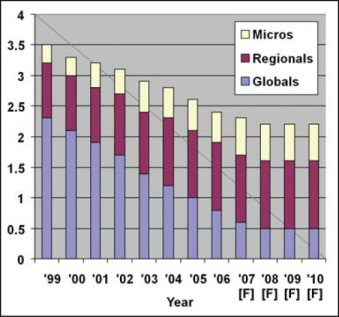
Although the total on trade is still forecast to continue a slight fall cask ale is now expected to go into growth within the next couple of years. Added to this there are a number of social trends recently coming into play, all of which place cask ale as the favoured product and all pointing to the case for the publican considering cask ale as a major plank in any future marketing strategy.
Consumer trends throughout the whole area of catering and leisure are towards ever increasing demand for more variety, new flavours, more natural products, rejection of standard brands for craft products etc. All of these point to the strongly regionally identified, hand-made product that is real ale. Even non cask beer drinkers in large part choose their destination pub by the range of ales on offer because the cask drinkers have more committed views and sway the decision; furthermore a pub with a good reputation for the quality its real ales acquires a 'cachet of competence' in the view of all customers regardless of their chosen tipple.
Cask ale seems to be ever more favoured by the A, B and C1 socio-economic groups, as shown by the chart below.
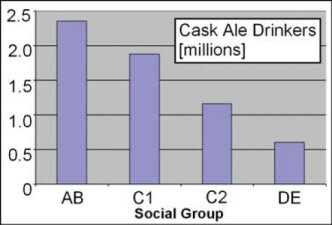
This is of course regrettable from a social viewpoint but for the purely economic wellbeing of the business attracting the A and B groups as clientele must be advantageous!
The growing awareness of green issues is also a strong pointer towards consumption of a real ale rather than a mass marketed lager. As far back as 2002 Ethical Consumer magazine calculated that ingredients for a local real ale brewery travelled on average 600 miles to the drinker whilst an imported lager could be as much as 24,000 miles! The figures for a Chilean red or a New Zealand Sauvignon defy the imagination. All cask beer is in fully returnable packages — no cans into the landfill. The next chart shows the impact of the green debate on drinkers attitudes, it shows the response of the adult population (millions) to the question: "Does the fact of lower 'beer miles' make you more likely to drink locally brewed cask ale or visit a pub that stocks it?"
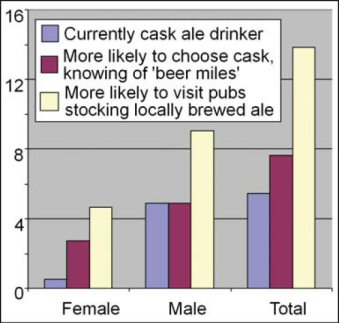
Even the binge drinking problem also has a positive influence on the sale of cask beer. The real ale drinker is a more contemplative, flavour aware individual and the drinks industry should champion him (and of course her) as mature examples of responsible drinking. With such encouragement of a civilised attitude to drinking (the much vaunted 'continental' model?) comes a growth of interest in the traditional mixed clientele pub and a backlash against High Street vertical drinking factories.
The report goes into considerable detail on the significance and even symbolism of that iconic badge of real ale, the hand pump or handpull in their preferred phrasing. Throughout there is a rightful insistence on the absolute priority of quality. As a government might say, the message is quality, quality, quality.
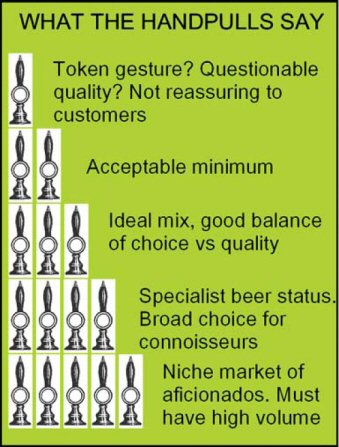
The research showed that 85% of consumers put good quality as the major factor in the choice of pub — way ahead of price. Previous studies have shown that more than half of drinkers will leave a pub if served with poor quality beer and of these 60% will never return. Even non beer drinkers know that cask ales have to be treated with care and if a pub is known for serving great cask ale then all other aspects, the food, the toilet cleanliness (an increasingly vital marketing point) and all the other drinks will be trusted as well.
The editor of the publicans' newspaper, The Morning Advertiser, Andrew Pring speaking on the report said of the cask ale market:
"It is the most exciting time I've known for cask ale ... but, as ever, the greatest challenge is consistent quality. There are still too many ale pints being sold that aren't right."
One item in the conclusions at the end of the document catches the attention particularly — the importance of cask ale pubs having a recognised, and always offered, regime of samples. The modern pub clientele has many who have not been brought up to be familiar with cask ales and the modern range of cask ales has a much broader spread of flavours than in the days of the old public bar's 'mild, bitter or mixed.'
This important 31 page report, which is entitled The Intelligent Choice, has been compiled and edited by Pete Brown, a professional freelance beer writer. It is directed at a wide audience but especially at licensees, pub chain managers and brewery professionals. It is available as a free download (in colour PDF format) from: http://www.caskreport.co.uk/pdf/Cask%20report_2009-10.pdf Readers are strongly advised to sacrifice a few seconds of their broadband usage (1.54MB) and a few percent of their printer's consumables for the opportunity to read and re-read it.
Hop Press Issue number 63. November 2007
Editor: Pat O'Neill
1 Surbiton Road
Eastleigh
Hants.
SO50 4HY
023 8064 2246
hop-press@shantscamra.org.uk
© CAMRA Ltd. 2007


|
© 2025 CAMRA Ltd. All rights reserved. Campaign for Real Ale, Southern Hampshire Branch Pages supplied by & updated by the Webmaster: Pete Horn [View Site Disclaimer, Personal Data Handing, and Cookie information] [Site History] |